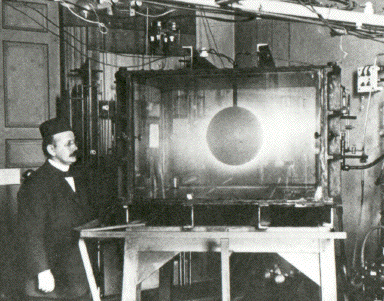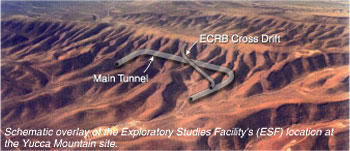Kristian Birkeland's magnetic museum: or, 'sunspots like no one else can do better'
Kristian Birkeland, the first scientist correctly to deduce the solar-magnetic origin of the Northern Lights, at one point was obsessed with building an experimental device here on Earth that could reproduce those polar-bound auroral effects. Though he started off only vaguely over-ambitious, a combination of hyper-caffeination in the Egyptian desert and addiction to veronal produced BLDGBLOG-worthy architectural hubris I feel should be quoted here in full. So, bearing in mind that this is a true story:
1) Birkeland's vacuum chamber was a 'machine in which to recreate many phenomena of the solar system beyond the Earth. He drew up plans for a new machine unlike anything that had been made before. ...[L]ike a spacious aquarium, [the box] would provide a window into space. The box would be pumped out to create a vacuum and he would use larger globes and a more powerful cathode to produce charged particles. With so much more room he would be able to see effects, obscured in the smaller tubes, that could take his Northern Lights theory one step further – into a complete cosmogony, a theory of the origins of the universe. (...) All sorts of beautiful solar phenomena could recreated this way, such as the sun's corona, the shining layers of the sun's outer atmosphere, usually visible only during a total eclipse. He could reproduce sunspots that moved across the surface of the terrella [the electrical globe-mechanism inside the vacuum chamber itself]... With this extraordinary machine Birkeland was able to simulate Saturn's rings, comet tails, and the Zodiacal Light. He even experimented with space propulsion using cathode rays. Sophisticated photographs were taken of each simulation, to be included in the next volume of Birkeland's great work, which would discern the electromagnetic nature of the universe and his theories about the formation of the solar system.'

The ensuing period of nearly hypnotised overwork is referred to later as 'Birkeland's immersion into the universe of his vacuum chamber'.
2) But then he got ambitious. In a letter written from a hotel in Aboukir, Egypt, where Birkeland's addiction to caffeine and veronal was driving him insane – along with the Saharan sun – he wrote: 'And, finally, I am going to tell you about a great idea I have had; it's a bit premature but I think it will be realised. I am going to get some money from the state and from friends, to build a museum for the discovery of *the Earth's magnetism, magnetic storms, the nature of sunspots, of planets – their nature and creation*. On a little hill I will build a dome of granite, the walls will be a metre thick, the floor will be formed of the mountain itself and the top of the dome, fourteen metres in diametre, will be a gilded copper sphere. Can you guess what the dome will cover? When I'm boasting I say to my friends here "next to God, I have the greatest vacuum chamber in the world." I will make a vacuum chamber of 1,000 cubic metres and, every Sunday, people will have the opportunity to see a ring of Saturn ten metres in diametre, sunspots like no one else can do better, Zodiacal Light as evocative as the natural one and, finally, auroras... four metres in diametre. The same sphere will serve as Saturn, the sun, and Earth, and will be driven round by a motor.'
So aside from conjuring up images somewhere between *Frankenstein*, *City of Lost Children* and *Batman*, perhaps, Birkeland's mountaintop cosmogonic laboratory brings up the interesting possibility of modeling – even reproducing – the universe through architecture. Or, at least, through a combination of architecture and machinery (which is what architecture always was in the first place).
In any case, clue the United States Department of Energy in on this and you'll – wait: they've already done it. It's called Yucca Mountain.


Perhaps a subterranean tour of the carved radioactive vaults of Yucca Mountain will be available to someone in a few ten-thousand years. By which time Birkeland's almost HP Lovecraftian visions of simulating the birth of the universe atop a granite mountaintop, beneath a copper dome, will be long forgotten.
Oh, and one more thing – in fact, two more things: 1) note that cathode rays, which Birkeland used in his vacuum chambers, are also what make non-digital television possible (raising the intellectually stimulating idea that television, in and of itself, as a *technical object*, is a model of the cosmos); and 2) note that Birkeland says 'next to God, I have the greatest vacuum chamber', implying of course that the universe already *is* a vacuum chamber, in which case one could argue – at least rhetorically – that we are living not in the universe as such but in what is *already* the experimental reproduction of the universe, a universe which lies elsewhere. The universe itself, then, the universe we run tests on and live within, is just a model, a prototype even. But that's neither here nor there...
1) Birkeland's vacuum chamber was a 'machine in which to recreate many phenomena of the solar system beyond the Earth. He drew up plans for a new machine unlike anything that had been made before. ...[L]ike a spacious aquarium, [the box] would provide a window into space. The box would be pumped out to create a vacuum and he would use larger globes and a more powerful cathode to produce charged particles. With so much more room he would be able to see effects, obscured in the smaller tubes, that could take his Northern Lights theory one step further – into a complete cosmogony, a theory of the origins of the universe. (...) All sorts of beautiful solar phenomena could recreated this way, such as the sun's corona, the shining layers of the sun's outer atmosphere, usually visible only during a total eclipse. He could reproduce sunspots that moved across the surface of the terrella [the electrical globe-mechanism inside the vacuum chamber itself]... With this extraordinary machine Birkeland was able to simulate Saturn's rings, comet tails, and the Zodiacal Light. He even experimented with space propulsion using cathode rays. Sophisticated photographs were taken of each simulation, to be included in the next volume of Birkeland's great work, which would discern the electromagnetic nature of the universe and his theories about the formation of the solar system.'

The ensuing period of nearly hypnotised overwork is referred to later as 'Birkeland's immersion into the universe of his vacuum chamber'.
2) But then he got ambitious. In a letter written from a hotel in Aboukir, Egypt, where Birkeland's addiction to caffeine and veronal was driving him insane – along with the Saharan sun – he wrote: 'And, finally, I am going to tell you about a great idea I have had; it's a bit premature but I think it will be realised. I am going to get some money from the state and from friends, to build a museum for the discovery of *the Earth's magnetism, magnetic storms, the nature of sunspots, of planets – their nature and creation*. On a little hill I will build a dome of granite, the walls will be a metre thick, the floor will be formed of the mountain itself and the top of the dome, fourteen metres in diametre, will be a gilded copper sphere. Can you guess what the dome will cover? When I'm boasting I say to my friends here "next to God, I have the greatest vacuum chamber in the world." I will make a vacuum chamber of 1,000 cubic metres and, every Sunday, people will have the opportunity to see a ring of Saturn ten metres in diametre, sunspots like no one else can do better, Zodiacal Light as evocative as the natural one and, finally, auroras... four metres in diametre. The same sphere will serve as Saturn, the sun, and Earth, and will be driven round by a motor.'
So aside from conjuring up images somewhere between *Frankenstein*, *City of Lost Children* and *Batman*, perhaps, Birkeland's mountaintop cosmogonic laboratory brings up the interesting possibility of modeling – even reproducing – the universe through architecture. Or, at least, through a combination of architecture and machinery (which is what architecture always was in the first place).
In any case, clue the United States Department of Energy in on this and you'll – wait: they've already done it. It's called Yucca Mountain.


Perhaps a subterranean tour of the carved radioactive vaults of Yucca Mountain will be available to someone in a few ten-thousand years. By which time Birkeland's almost HP Lovecraftian visions of simulating the birth of the universe atop a granite mountaintop, beneath a copper dome, will be long forgotten.
Oh, and one more thing – in fact, two more things: 1) note that cathode rays, which Birkeland used in his vacuum chambers, are also what make non-digital television possible (raising the intellectually stimulating idea that television, in and of itself, as a *technical object*, is a model of the cosmos); and 2) note that Birkeland says 'next to God, I have the greatest vacuum chamber', implying of course that the universe already *is* a vacuum chamber, in which case one could argue – at least rhetorically – that we are living not in the universe as such but in what is *already* the experimental reproduction of the universe, a universe which lies elsewhere. The universe itself, then, the universe we run tests on and live within, is just a model, a prototype even. But that's neither here nor there...





Comments are moderated.
If it's not spam, it will appear here shortly!
Post a Comment